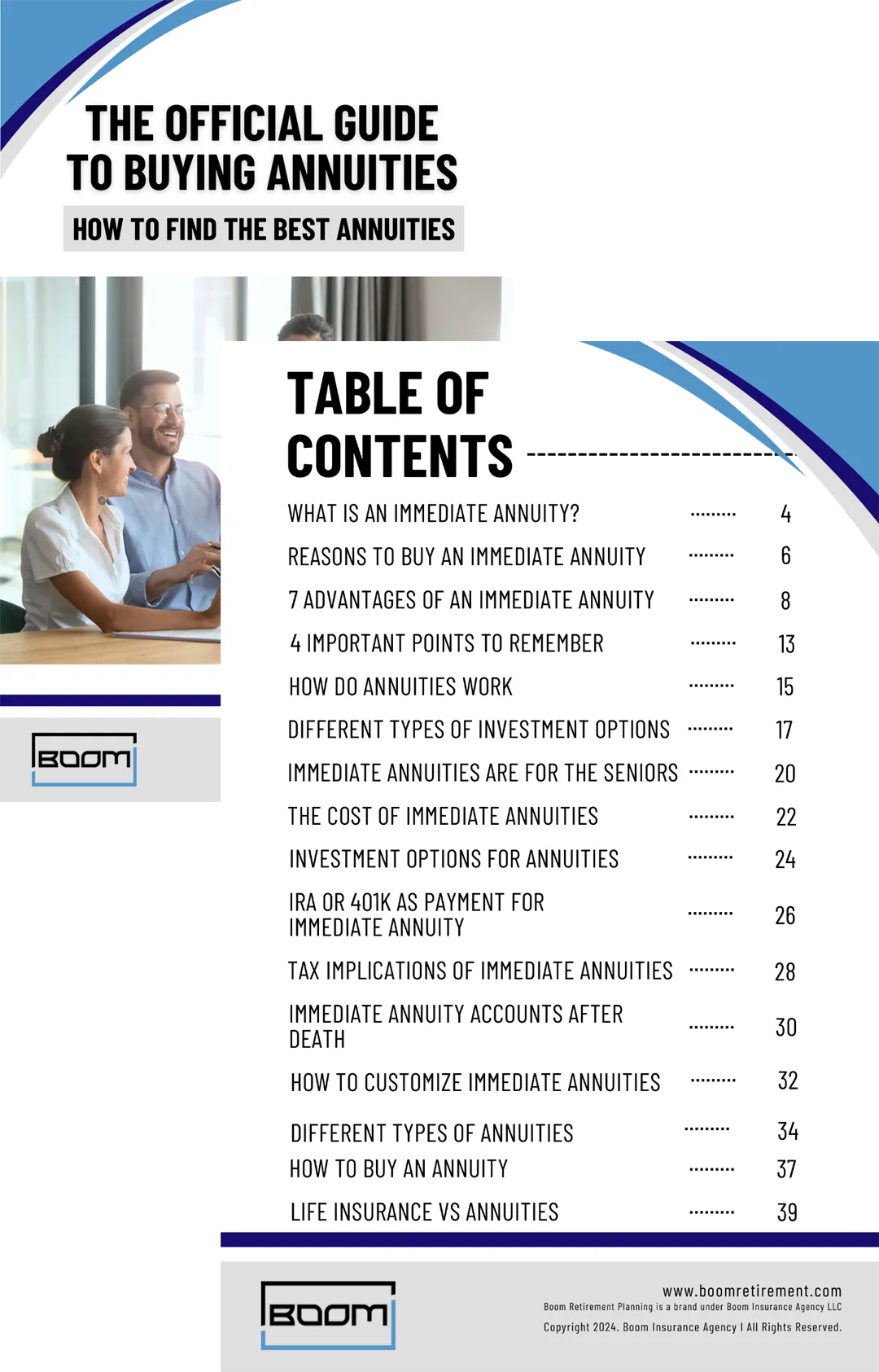
BOOM RETIREMENT SOLUTIONS
Strategies for Boosting Retirement Income

Top Retirement Cash Flow Risks
Why you need this Retirement Toolkit
Will outlive your retirement savings?
Will taxes and inflation erode your Retirement Nest Egg?
Will you head into retirement using an Accumulation Strategy or a Decumulation Strategy?
Will you maintain your lifestyle in a market downturn?
Are you prepared for RMD's and IRMAA?
BOOM RETIREMENT PLANNING
Strategies for Boosting Retirement Income
If You Ask 50 Financial Advisors,
"What is the best way to retire?".
You will get 50 different answers!
That is because despite all their training and certifications,
financial advisors each bring their own perspectives, experiences, and
biases to the table, leading to varied approaches and strategies tailored to their
unique understanding of the market, client needs, and risk tolerance.
Economic Science and Math proves...
There is Only One Optimal Way to Retire
Over 6 Decades of Research Created the 7 Steps Below.
Develop a Plan: Assess your financial situation, retirement goals, income sources and monthly budget for expenses.
Secure Lifetime Income: Consider products like private pensions for guaranteed income.
Maximize Social Security: Optimize benefits by understanding your options; delaying to 67 or 70 can help.
Diversify Investments: Build a balanced portfolio—30% cash value life insurance, 30% lifetime income, 40% growth assets.
Prepare for Health Care Costs: Budget for health expenses, including long-term care, which most seniors will need.
Use Tax-Efficient Strategies: Consider Roth conversions to reduce retirement taxes.
Stay Active and Engaged: Pursue activities for mental, physical, and emotional well-being in retirement.
Our Blog

In-Service 401(k) Rollover into a Fixed Indexed Annuity: Why It Might Be the Better Choice
In-Service 401(k) Rollover into a Fixed Indexed Annuity: Why It Might Be the Better Choice
Retirement planning is a crucial aspect of financial management, especially as you approach the later stages of your career. One option that many employees may not be aware of is the ability to roll over funds from their 401(k) into a Fixed Indexed Annuity (FIA) while still employed, known as an in-service 401(k) rollover. This blog post will explore what an in-service 401(k) rollover is, the benefits of rolling over into a Fixed Indexed Annuity, and why this might be the superior choice for securing your retirement.
Understanding In-Service 401(k) Rollovers
An in-service 401(k) rollover allows you to transfer a portion of your vested 401(k) balance into another qualified retirement account, such as an IRA or an annuity, while you are still employed. This option is not available in all 401(k) plans, so it’s essential to check with your plan administrator to see if your plan permits it.
Key Features of In-Service 401(k) Rollovers
Age Requirement:
Generally available to participants who are 59½ years or older, although some plans may allow it at an earlier age.
Partial Rollover:
You can choose to roll over only a portion of your 401(k) balance, allowing you to keep some funds in your existing 401(k) plan.
Tax-Free Transfer:
The rollover is a direct transfer between retirement accounts, so it is not considered a taxable event as long as the funds are moved directly and not withdrawn.
Flexibility and Control:
Provides more control over your retirement savings by diversifying your investment options and potentially accessing more favorable investment products.
What Is a Fixed Indexed Annuity (FIA)?
A Fixed Indexed Annuity (FIA) is a type of insurance product that provides a guaranteed minimum interest rate combined with the potential for higher returns linked to a specific market index, such as the S&P 500. FIAs are designed to offer principal protection, tax-deferred growth, and the possibility of a steady income stream in retirement.
Key Features of a Fixed Indexed Annuity
Principal Protection:
Your initial investment is protected from market downturns, ensuring you do not lose your principal.
Tax-Deferred Growth:
Earnings in an FIA grow tax-deferred until you withdraw them, similar to a traditional IRA or a 401(k).
Index-Linked Interest:
Potential for higher returns based on the performance of a market index, with a guaranteed minimum interest rate.
Lifetime Income Options:
FIAs can provide a stream of income for life, ensuring you do not outlive your savings.
No Contribution Limits:
Unlike IRAs, there are no contribution limits to an FIA, allowing you to invest as much as you want.
Flexibility in Withdrawals:
While there are penalties for early withdrawals (typically before age 59½), FIAs offer more flexibility in accessing your funds compared to IRAs.
Benefits of Rolling Over Your 401(k) into a Fixed Indexed Annuity
1. Enhanced Principal Protection
One of the primary reasons to consider rolling over your 401(k) into an FIA is the guaranteed protection of your principal. While 401(k) investments are subject to market risks, FIAs ensure that your initial investment remains safe regardless of market conditions. This feature provides peace of mind and financial security, especially during volatile market periods.
2. Potential for Higher Returns
FIAs offer the potential for higher returns linked to the performance of a specific market index. Unlike traditional fixed annuities, which provide a fixed interest rate, FIAs can yield more substantial returns when the market performs well. This combination of security and growth potential makes FIAs an attractive option for those looking to balance risk and reward.
3. Tax Advantages
Like 401(k) accounts, FIAs offer tax-deferred growth, meaning you do not pay taxes on the earnings until you withdraw them. This feature allows your investments to grow more quickly compared to taxable accounts. Additionally, rolling over your 401(k) into an FIA is a tax-free event, provided the transfer is done correctly, ensuring you do not incur immediate tax liabilities.
4. Guaranteed Lifetime Income
One of the most significant benefits of FIAs is the ability to provide a guaranteed income for life. This feature is particularly valuable for retirees concerned about outliving their savings. By rolling over your 401(k) into an FIA, you can secure a steady and predictable income stream that lasts throughout your retirement years.
5. No Contribution Limits
401(k) plans have annual contribution limits, which can restrict how much you can save each year. In contrast, FIAs do not have contribution limits, allowing you to invest as much as you want. This feature is especially beneficial for those who wish to maximize their retirement savings and take advantage of the tax-deferred growth potential.
6. Flexibility and Control
Rolling over your 401(k) into an FIA provides greater flexibility and control over your retirement savings. You can choose the specific annuity product that best meets your needs, access various investment options, and tailor your retirement income strategy. This level of customization is often not available with employer-sponsored 401(k) plans.
How to Perform an In-Service 401(k) Rollover into a Fixed Indexed Annuity
1. Check Your 401(k) Plan’s Rules
Not all 401(k) plans allow in-service rollovers, so the first step is to check with your plan administrator or review your plan documents to see if this option is available to you.
2. Assess Your Financial Situation
Evaluate your current financial situation, retirement goals, and risk tolerance to determine if rolling over into an FIA is the right decision for you. Consider consulting a retirement specialist to gain insights and advice tailored to your specific needs.
3. Choose the Right FIA
There are various FIAs available, each with different features, fees, and interest crediting methods. Research and compare different products to find the one that best aligns with your financial goals and risk tolerance.
4. Initiate the Rollover
Once you have selected an FIA, work with your retirement specialist to initiate the rollover process. This typically involves completing paperwork and coordinating with your 401(k) plan administrator and the annuity provider to ensure a smooth and tax-free transfer of funds.
5. Monitor Your Investment
After completing the rollover, it’s essential to monitor your FIA and stay informed about its performance. Keep in touch with your retirement specialist to review your retirement plan regularly and make any necessary adjustments.
Conclusion: Why a Fixed Indexed Annuity Might Be the Better Choice
While 401(k) plans are excellent tools for building retirement savings, they come with certain limitations and risks. Rolling over your 401(k) into a Fixed Indexed Annuity offers several advantages that can enhance your retirement security and financial well-being.
1. Superior Principal Protection
Unlike 401(k) investments, which are subject to market volatility, FIAs guarantee the protection of your principal. This feature ensures that your hard-earned savings are safe, providing a stable foundation for your retirement.
2. Attractive Growth Potential
FIAs offer the potential for higher returns linked to market performance while still providing a guaranteed minimum interest rate. This combination of growth and security can help you build a more robust retirement nest egg.
3. Tax-Deferred Growth
The tax-deferred growth offered by FIAs allows your investments to compound more efficiently over time, maximizing your retirement savings potential. This benefit, combined with the tax-free nature of the rollover, ensures you can grow your wealth without immediate tax concerns.
4. Guaranteed Lifetime Income
One of the standout features of FIAs is the ability to provide a guaranteed income for life. This ensures you have a steady and predictable income stream throughout your retirement, alleviating the worry of outliving your savings.
5. Flexibility and Control
By rolling over your 401(k) into an FIA, you gain more control over your retirement savings and the ability to customize your investment strategy. This flexibility allows you to tailor your retirement plan to your specific needs and goals, ensuring a more personalized approach to financial security.
6. No Contribution Limits
The absence of contribution limits in FIAs allows you to invest as much as you want, giving you the freedom to maximize your retirement savings. This feature is particularly advantageous for those looking to catch up on savings or take full advantage of tax-deferred growth.
In summary, while both 401(k) plans and Fixed Indexed Annuities have their merits, FIAs offer several distinct advantages that make them a superior choice for many individuals. The combination of principal protection, growth potential, tax advantages, guaranteed lifetime income, flexibility, and control make FIAs an attractive option for securing a financially stable and prosperous retirement.
If you're considering an in-service 401(k) rollover, consult with a retirement specialist to explore the benefits of a Fixed Indexed Annuity and determine if it aligns with your retirement goals. With the right information and guidance, you can make informed decisions that enhance your financial future and provide peace of mind in your retirement years.
Taxation can play a substantial role in determining
the overall value of your retirement portfolio
How are your current retirement income sources taxed?
Social Security
Qualified Accounts
Non-Qualified Accounts
Social Security is a federal government program in the United States that provides financial benefits to eligible individuals, primarily retirees, disabled individuals, and their families. It is funded through payroll taxes collected under the Federal Insurance Contributions Act (FICA) and the Self-Employment Contributions Act (SECA).
Key components of Social Security include:
Retirement Benefits: These benefits are available to workers who have paid into the Social Security system through payroll taxes during their working years. Individuals can start receiving reduced retirement benefits as early as age 62, but full benefits are available at the full retirement age, which varies depending on the year of birth. Delaying benefits beyond full retirement age can increase the monthly benefit amount.
Disability Benefits: Social Security Disability Insurance (SSDI) provides benefits to individuals who are unable to work due to a qualifying disability. To be eligible, individuals must have a sufficient work history and meet specific medical criteria.
Survivor Benefits: These benefits are paid to the surviving spouses, children, or dependents of deceased workers who paid into the Social Security system. The amount of the benefit depends on the deceased worker's earnings record.
Supplemental Security Income (SSI): Although administered by the Social Security Administration, SSI is a separate program funded by general tax revenues (not Social Security taxes). It provides financial assistance to elderly, blind, or disabled individuals with limited income and resources.
Social Security is a critical component of retirement planning for many Americans, providing a safety net to ensure a basic level of income in retirement, during periods of disability, or after the death of a family member.
Social Security benefits may be taxed based on your combined income, which includes adjusted gross income, nontaxable interest, and half of your Social Security benefits. Depending on your income level, up to 85% of your benefits could be subject to federal income tax.
A qualified account is a type of retirement savings account that offers tax advantages, typically regulated by the IRS under specific sections of the tax code. Contributions to qualified accounts are often tax-deferred, meaning that contributions are made with pre-tax dollars, reducing the individual's taxable income in the year of the contribution. Taxes on contributions and investment earnings are deferred until withdrawals are made, usually in retirement.
401(k) plans
403(b) plans
457 plans
Traditional IRAs
SEP IRAs
SIMPLE IRAs
Self Directed IRAs
Pensions
Annuities
Withdrawals from these accounts are generally subject to income tax, and there may be penalties for early withdrawals before a certain age (usually 59½). Additionally, qualified accounts are subject to Required Minimum Distributions (RMDs) once the account holder reaches age 73 (if born before 1960).
Required Minimum Distributions (RMDs) are the minimum amounts that retirees must withdraw annually from their tax-deferred retirement accounts, such as traditional IRAs and 401(k)s, starting at age 73 (as of 2023). The amount of the RMD is calculated based on the account balance and the account holder's life expectancy. Failing to take RMDs can result in significant tax penalties, including a hefty excise tax on the amount that should have been withdrawn.
A non-qualified account is a type of investment account that does not have the same tax advantages or restrictions as qualified retirement accounts. Unlike qualified accounts, contributions to non-qualified accounts are made with after-tax dollars, meaning there's no tax deduction for contributions.
Examples of non-qualified accounts include:
Brokerage accounts
Mutual fund accounts
Certificates of deposit
Savings accounts
Roth IRA
Cash Value Life Insurance
Annuities
These accounts are often used for general savings and investments outside of retirement, offering more flexibility in terms of contributions and withdrawals, but without the tax advantages of qualified accounts.
The exception is the Roth IRA in which the principal, interest, earnings and dividends are all tax-free. Roth IRAs are also not subject to RMD's.
A Roth conversion is the process of transferring funds from a Qualified retirement accounts into a Roth IRA (Non-Qualified Account). The converted amount is subject to income tax in the year of the conversion, but future withdrawals from the Roth IRA are tax-free, provided certain conditions are met. This strategy is often used to reduce taxable income in retirement and to avoid required minimum distributions (RMDs).
Books for Retirees and Soon-To-Bes
Choose Your Book
Retirement Income


Tax Strategies




Long Term Care



Boom Final Expense is a brand under Boom Insurance Agency LLC
©Copyright 2023| Boom Insurance Agency. All Right Reserved

Boom Retirement Planning is a brand under Boom Insurance Agency LLC
©Copyright 2024| Boom Insurance Agency. All Right Reserved





